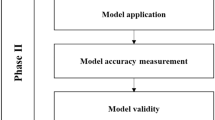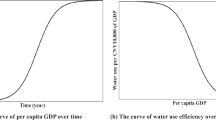Abstract
It is essential to establish the water resources exploitation and utilization planning, which is mainly based on recognizing and forecasting the water consumed structure rationally and scientifically. During the past 30 years (1980–2009), mean annual precipitation and total water resource of Beijing have decreased by 6.89% and 31.37% compared with those perennial values, respectively, while total water consumption during the same period reached pinnacle historically. Accordingly, it is of great significance for the harmony between socio-economic development and environmental development. Based on analyzing total water consumption, agricultural, industrial, domestic and environmental water consumption, and evolution of water consumed structure, further driving forces of evolution of total water consumption and water consumed structure are revealed systematically. Prediction and discussion are achieved for evolution of total water consumption, water consumed structure, and supply-demand situation of water resource in the near future of Beijing using Time Series Forecasting Method. The purpose of the endeavor of this paper is to provide scientific basis for the harmonious development between socio-economy and water resources, for the establishment of rational strategic planning of water resources, and for the social sustainable development of Beijing with scientific bases.
Similar content being viewed by others
References
Armstrong J, Fildes R, 2006. Making progress in forecasting. Int. J. Forecast, 22: 433–441.
Bougadis J, Adamowski K, Diduch R, 2005. Short-term municipal water demand forecasting. J. Hydrol. Process., 19: 137–148.
Chen Y N, Xu Z X, 2005. Plausible impact of global climate change on water resources in the Tarim River Basin. Science in China (Series D), 48(1): 65–73.
Chu J Y, Wang C, Chen J N et al., 2009. Agent-based residential water use behavior simulation and policy implications: A case-study in Beijing City. Water Resour. Manage., 23: 3267–3295.
Cui Y L, Wang Y B, Shao J L et al., 2009. Research on groundwater regulation and recovery in North China Plain after the implementation of South-to-North Water Transfer. Resources Science, 31(3): 382–387. (in Chinese)
Ding X Y, Jia Y W, Wang H et al., 2010. Impacts of climate change on water resources in the Haihe River Basin and corresponding countermeasures. Journal of Natural Resources, 25 (4): 604–613. (in Chinese)
Hao X M, Chen Y N, Xu C C et al., 2008. Impacts of climate change and human activities on the surface runoff in the Tarim River Basin over the last fifty years. Water Resour. Manage., 22: 1159–1171.
Huang Q X, He C Y, Shi P J et al., 2009. Modeling water resources carrying capacity change under stress of drought and socio-economic development in Beijing. Journal of Natural Resources, 24(5): 859–870. (in Chinese)
Jain A, Joshi U, Varshney A, 2001. Short-term water demand forecast modeling at IIT Kanpur using artificial neural networks. Water Resour. Manage., 15: 299–321.
Labat D, Godderis Y, Probst J L et al., 2004. Evidence for global runoff increase related to climate warming. Adv. Water Resour., 27: 631–642.
Lioubimtseva E, Cole R, Adams J M et al., 2005. Impacts of climate and land-cover changes in arid lands of Central Asia. J. Arid Environ., 62: 285–308.
Liu B Q, Yao Z J, Gao Y C, 2003. Trend and driving forces of water consumed structure changes in Beijing. Resources Science, 25(2): 38–43. (in Chinese)
Liu J H, Qin D Y, Wang H et al., 2010. Dualistic water cycle pattern and its evolution in Haihe River Basin. Chinese Science Bulletin, 55(16): 1688–1697.
Mohamed M M, Aysha A A, 2010. Water demand forecasting in Umm Al-Quwain (UAE) using the IWR-MAIN specify forecasting model. Water Resour. Manage., 24: 4093–4120.
Qin L, Zhou X, 2010. Estimating possible impact of human activity on the warm season temperature in Beijing since the industrial era. Chinese Science Bulletin, 55(16): 1590–1593.
Song X F, Li F D, Yu J J et al., 2007. Characteristics of groundwater cycle using deuterium, oxygen-18 and hydrochemistry in Chaobai River Basin. Geographical Research, 26(1): 1–21. (in Chinese)
Xu C Y, 2000. Modeling the effects of climate change on water resources in Central Sweden. Water Resour. Manage., 14(3): 177–189.
Zhang H, Wu J W, Zheng Q H et al., 2003. A preliminary study of oasis evolution in the Tarim Basin, Xinjiang, China. J. Arid Environ., 55: 545–553.
Zhang Y K, Schilling K E, 2006. Increasing streamflow and baseflow in Mississippi River since the 1940s: Effect of land use change. J. Hydrol., 324: 412–422.
Author information
Authors and Affiliations
Corresponding author
Additional information
Foundation: Key Project of Science and Technology granted by Beijing Municipal Science & Technology Commission, No.D07050601510000
Author: Zhai Yuanzheng (1983–), Ph.D and Lecturer, specialized in hydrology.
Rights and permissions
About this article
Cite this article
Zhai, Y., Wang, J., Teng, Y. et al. Water demand forecasting of Beijing using the Time Series Forecasting Method. J. Geogr. Sci. 22, 919–932 (2012). https://doi.org/10.1007/s11442-012-0973-7
Received:
Accepted:
Published:
Issue Date:
DOI: https://doi.org/10.1007/s11442-012-0973-7




